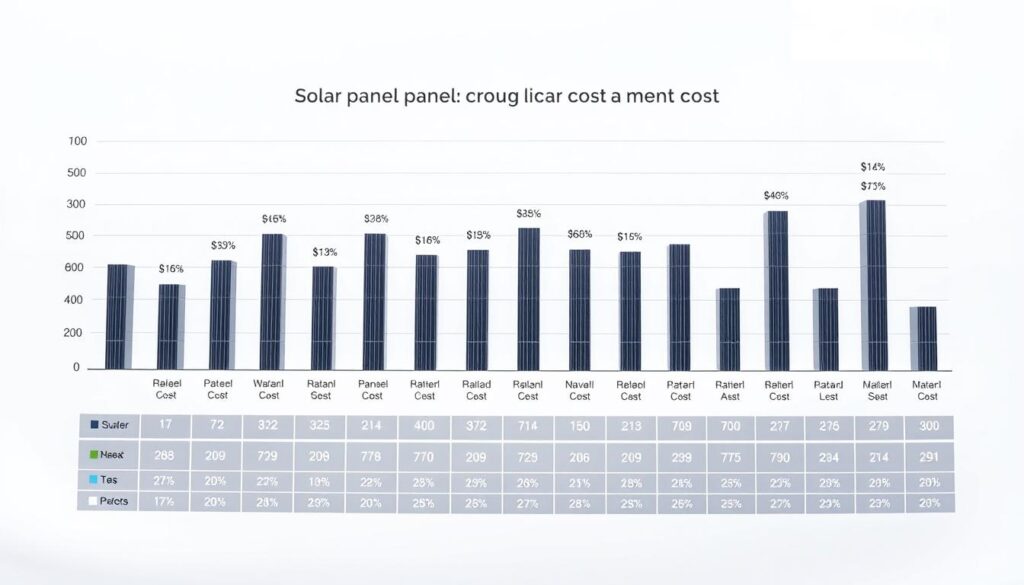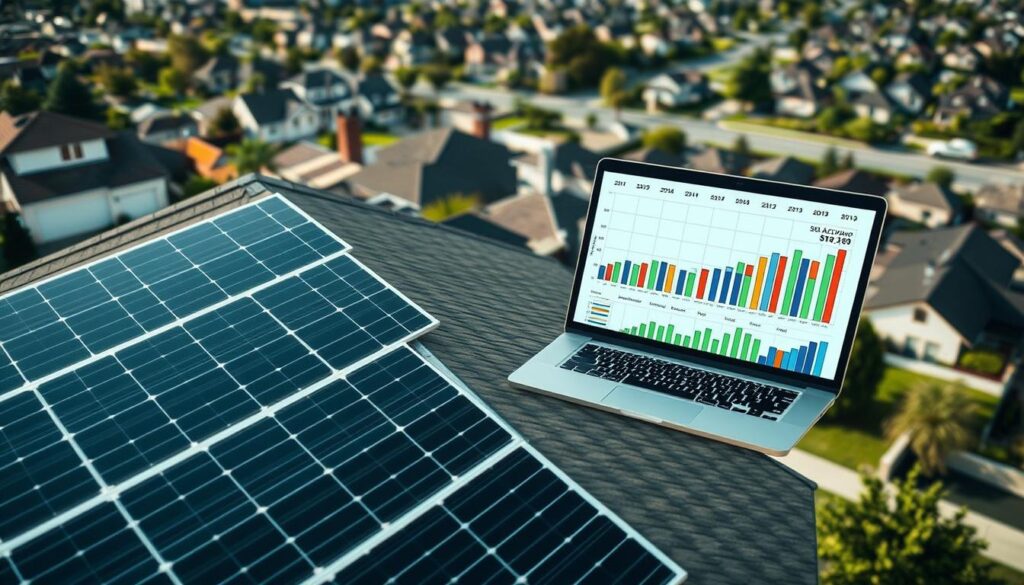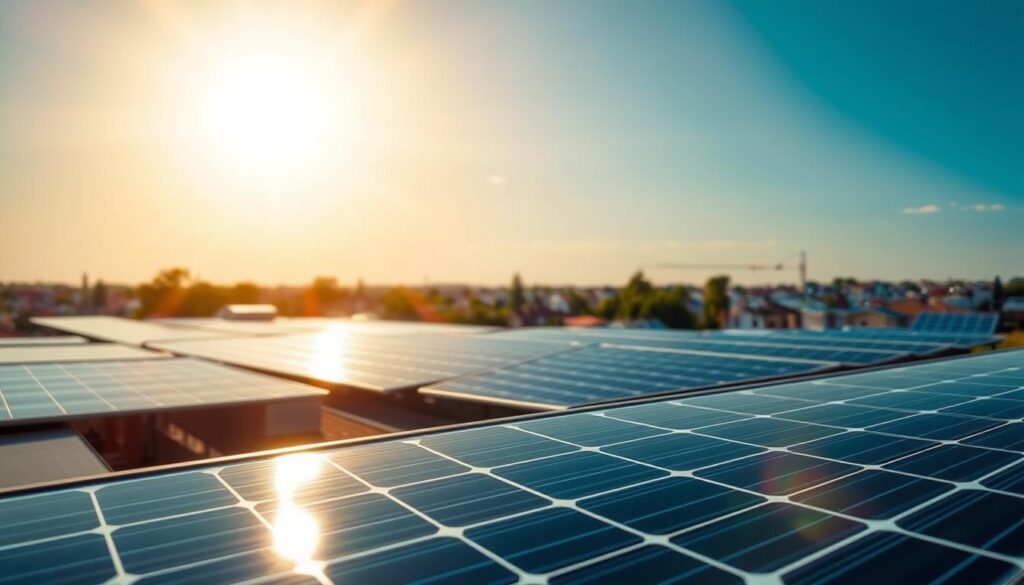Thinking about switching to renewable energy? You’re not alone. Many homeowners are exploring solar panel options to reduce their electricity bills and environmental impact. In 2023, the cost of installing a system has become more affordable, thanks to advancements in technology and available incentives.
This guide breaks down the key factors that influence pricing, such as system size, efficiency, and installation expenses. You’ll also learn how federal tax credits and local incentives can significantly lower your upfront investment. Whether you’re looking to save money or embrace clean energy, this article will help you make an informed decision.
Key Takeaways
- Understand the factors that influence solar panel pricing in 2023.
- Learn how federal tax credits can reduce your upfront costs.
- Discover state-specific incentives that make solar more affordable.
- Explore the impact of system size and efficiency on overall expenses.
- Get insights into financing options for your solar installation.
Overview of Home Solar Panels Cost in 2023
Exploring renewable energy options? Here’s what you need to know about pricing in 2023. According to EnergySage, the average expense for an 11 kW system is around $20,552 after applying available incentives. This includes federal tax credits, which can significantly reduce your upfront investment.
Before incentives, prices typically range from $25,000 to $30,000 for a standard setup. The total cost depends on factors like system size, equipment quality, and installation complexity. For example, a 6 kW setup might cost $18,500, while a 10 kW system could reach $22,500.
Regional trends also play a role. In Arizona, a 6 kW system averages $13,980, while in Colorado, it’s closer to $18,780. These variations highlight the importance of comparing prices across different states.
Understanding these numbers sets the foundation for deeper insights into financing, savings, and long-term benefits. Whether you’re looking to reduce your energy bills or contribute to a greener future, this overview helps you make an informed decision.
Key Factors Influencing Solar Panel Prices
Curious about what drives the price of renewable energy systems? Several factors play a role, from the type of equipment you choose to the size of the setup. Understanding these elements can help you make a smarter investment.

Panel Choice and Efficiency
The type of panel you select significantly impacts the overall price. Monocrystalline panels, known for their high efficiency (15%-22%), are often more expensive than polycrystalline or thin-film options. Brands like SunPower offer premium models that deliver more power in a smaller area, making them ideal for limited roof space.
Higher efficiency means fewer panels are needed to meet your energy needs. While this reduces installation complexity, it can increase upfront costs. For example, panels with 20% efficiency might cost more than those with 18%, but they offer better long-term savings.
System Size and Energy Requirements
The size of your system is another critical factor. Larger setups generate more electricity but come with higher initial expenses. For instance, a 12 kW system for a 2,500-square-foot home averages $24,047 after incentives, while a smaller 5 kW system costs around $11,202.
Your household’s energy consumption determines the ideal size. A home using 12,000 kWh annually will need more panels than one using 8,000 kWh. Balancing upfront costs with long-term savings is key to maximizing your investment.
“Choosing the right combination of panel type and system size ensures optimal performance and financial return.”
| Panel Type | Efficiency | Average Cost per Watt |
|---|---|---|
| Monocrystalline | 15%-22% | $0.90-$1.20 |
| Polycrystalline | 13%-17% | $0.70-$0.90 |
| Thin-Film | 10%-13% | $0.50-$0.70 |
Ultimately, your choice of equipment and system size will shape both the upfront price and long-term benefits. By carefully evaluating your needs and options, you can create a setup that delivers maximum value.
Breaking Down Installation Expenses
Understanding the breakdown of installation expenses can help you make a smarter investment. While the system itself is a significant part of the budget, other factors like labor, permitting, and overhead also play a crucial role. Let’s dive into the details to see where your money goes.
Equipment and Material Costs
Nearly half of the total price comes from equipment and materials. This includes panels, inverters, racking systems, and wiring. High-quality components often come with a higher upfront cost but offer better long-term performance.
For example, inverters alone account for about 10% of the total expense. Racking systems and wiring add another 12%. These costs can vary depending on the system size and the complexity of your setup.
Labor, Permitting, and Overhead
Labor and permitting fees are another major factor. Skilled installers ensure your system is set up correctly, but their expertise comes at a price. On average, labor costs make up about 7% of the total expense.
Permitting and interconnection fees add another 8%. These are necessary to comply with local regulations and ensure your system is connected to the grid. Overhead costs, including sales and marketing, can account for nearly 20% of the total price.
“Knowing the breakdown of costs empowers homeowners to negotiate better deals and understand the value they’re getting.”
By understanding these individual expenses, you can make informed decisions and potentially save money. Whether you’re focused on quality or affordability, a clear breakdown ensures you get the most out of your investment.
Comparing Solar Costs Across States
The price of renewable energy systems can vary significantly depending on where you live. Factors like local labor rates, permitting fees, and sun exposure all play a role in determining the final price. For example, states with abundant sunlight often have lower costs per watt, but the system size required may differ based on energy needs.

Regional Price Variations
Data from EnergySage shows that installation expenses differ widely across the U.S. In California, the average cost for a 6 kW system is around $13,980, while in West Virginia, it’s closer to $18,780. These variations highlight the importance of location-specific insights when planning your investment.
Warmer states like Arizona benefit from lower prices due to higher sun exposure and competitive labor markets. However, states with stricter permitting processes, such as New York, may see higher upfront expenses. Understanding these regional differences can help you identify the best deals in your state.
“Comparing costs across states empowers homeowners to make informed decisions and maximize their savings.”
By analyzing regional trends, you can better understand how factors like climate, regulations, and local incentives impact your overall cost. Whether you’re in a sunny state or a region with higher labor rates, these insights ensure you get the most value from your renewable energy investment.
Leveraging Federal and Local Incentives
Maximizing savings on renewable energy systems is easier than you think. Federal and local programs can significantly reduce your upfront expenses, making the switch more affordable. Let’s explore how these incentives work and how you can take advantage of them.
Federal Solar Tax Credit Benefits
The federal solar tax credit, also known as the Investment Tax Credit (ITC), is one of the most valuable incentives available. It allows you to deduct 30% of your system’s total cost from your federal taxes. This includes expenses for equipment, labor, and installation.
For example, if your system costs $20,000, you could save $6,000 through this credit. This incentive is non-refundable, meaning it reduces your tax liability but won’t result in a refund if your credit exceeds what you owe.
“The federal solar tax credit has been a game-changer for homeowners, making renewable energy more accessible and affordable.”
State Rebates and Net Metering Programs
In addition to federal incentives, many states offer their own programs to encourage renewable energy adoption. These include cash rebates, property tax exemptions, and net metering policies.
For instance, Arizona provides a state tax credit of up to $1,000 and eliminates sales tax on panel purchases. Net metering allows you to sell excess electricity back to the grid, further reducing your energy bills.
Combining these programs with the federal tax credit can lead to substantial savings. EnergySage data shows that the average cost of a system can drop from $29,360 to around $20,552 after incentives.
| Incentive Type | Savings Potential | Eligibility |
|---|---|---|
| Federal Tax Credit | 30% of total cost | All U.S. homeowners |
| State Rebates | Varies by state | State-specific |
| Net Metering | Reduces energy bills | Utility-dependent |
To maximize your savings, research local programs and ensure you meet all eligibility requirements. Applying for multiple incentives can significantly improve your return on investment and shorten the payback period for your system.
Evaluating the Investment: Is Solar Worth It?
Deciding to invest in renewable energy requires careful evaluation of its financial benefits. While the upfront price may seem high, the long-term savings on electricity bills and the potential for a quick payback period make it a compelling choice for many homeowners.

Electricity Bill Savings and Payback Period
One of the biggest advantages of switching to renewable energy is the reduction in monthly electricity bills. On average, homeowners can save between $20,000 and $90,000 over 25 years, depending on their system size and local utility rates. These savings can significantly offset the initial investment.
Net metering programs further enhance these benefits. By selling excess power back to the grid, homeowners can earn credits that reduce their bill even more. In areas with high electricity rates, this can shorten the payback period to as little as 3.7 years.
“The combination of lower bills and net metering makes renewable energy a financially sound choice for many households.”
Additionally, rising energy costs favor this investment. As utility prices increase, the savings from generating your own power become even more significant. Over time, this can lead to substantial financial gains.
By carefully evaluating these factors, homeowners can determine if renewable energy is the right choice for their needs. With the right setup, the price of installation can be quickly recouped, making it a smart long-term investment.
How to Lower Your Home Solar Panels Cost
Looking to reduce your expenses while embracing clean energy? Here’s how. By exploring alternative financing options and securing multiple quotes, you can significantly lower your upfront investment. Let’s dive into the strategies that make this possible.

Exploring Alternative Financing Options
One of the best ways to reduce your initial expenses is through financing. Options like low-interest loans or zero-down plans can save you up to 47% compared to outright purchases. These methods spread the price over time, making it easier to manage your budget.
Leasing is another popular choice. It allows you to enjoy the benefits of a system without owning it outright. While you won’t own the equipment, you’ll still save on your monthly electricity bills. This flexibility makes renewable energy accessible to more homeowners.
“Financing options can make renewable energy more affordable, helping you save money while reducing your carbon footprint.”
Securing Multiple Installer Quotes
Getting several quotes from different installers is crucial. Prices can vary widely based on the company, equipment, and labor costs. By comparing offers, you can find the best deal for your needs.
Don’t hesitate to negotiate. Many installers are willing to adjust their price to win your business. Look for detailed breakdowns of costs, including equipment, labor, and permits. This transparency ensures you’re getting a fair deal.
Reading customer reviews and checking installer ratings can also help you make an informed decision. A reputable company with positive feedback is more likely to deliver quality work and reliable service.
By combining financing options with competitive quotes, you can significantly reduce your upfront expenses. This approach makes renewable energy a smart and accessible choice for your home.
Conclusion
Evaluating the financial side of renewable energy is essential for informed decisions. The cost of a system depends on factors like panel choice, installation complexity, and regional variations. Leveraging federal and state incentives can significantly reduce your upfront expenses.
Comparing quotes from different installers ensures you get the best deal. Financing options like loans or leases can make the transition more affordable. By exploring local programs and incentives, you can maximize your savings and shorten the payback period.
Investing in clean energy is not just about the initial price. It’s about long-term savings and energy independence. Take the next step by researching your local options and finding the right solution for your needs.
